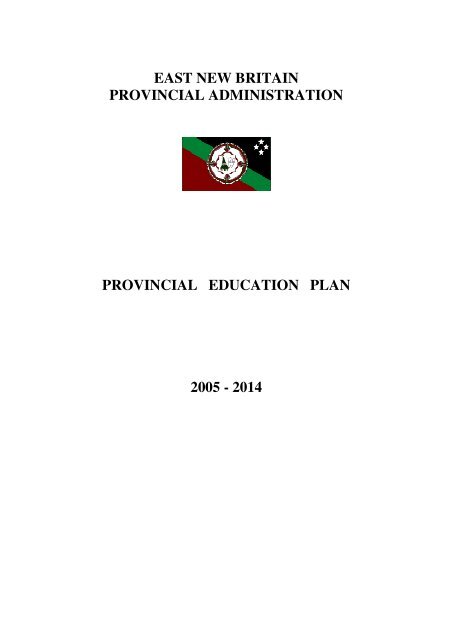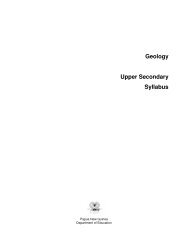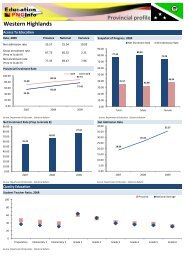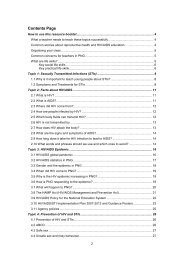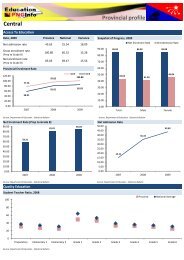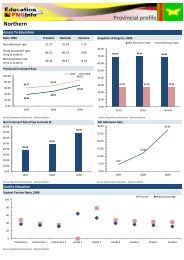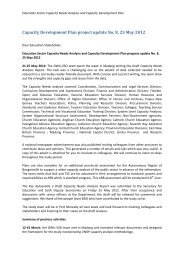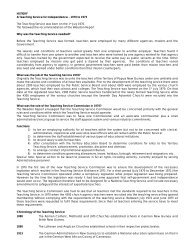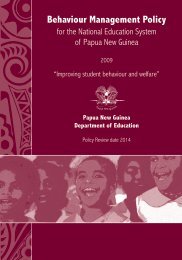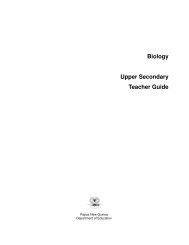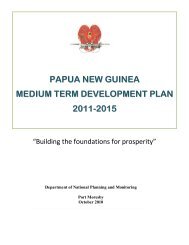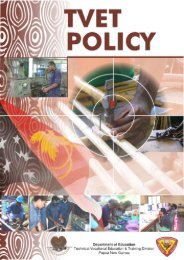East New Britain - Department of Education
East New Britain - Department of Education
East New Britain - Department of Education
You also want an ePaper? Increase the reach of your titles
YUMPU automatically turns print PDFs into web optimized ePapers that Google loves.
ATTAINING A BETTER FUTURECHAIRMAN’S MESSAGEThis plan builds on the progress made in the Provincial <strong>Education</strong>Development Plan and <strong>Education</strong> Reform Implementation Strategies 1997 –2004, which was also consistent with the National <strong>Education</strong> Plan, 1995 –2004. The new and <strong>Education</strong> Reform Implementation Strategies <strong>Education</strong>Plan presents the outcomes for education in <strong>East</strong> <strong>New</strong> <strong>Britain</strong> and thestrategies used in achieving Universal Primary <strong>Education</strong> up to Grade 8level by 2014. We will sustain this and also improve on our retention ratesat all levels <strong>of</strong> schools in the province. We remain committed to teaching the first three years in thelanguage <strong>of</strong> the community.On completing the nine years <strong>of</strong> basic education, our young people will have a number <strong>of</strong> pathways availableto them. All students who complete their basic education will receive financial assistance for their futureeducation or training. Some academically talented students will receive special funding assistance to enablethem to progress as far as their ability allow. In the area <strong>of</strong> skills training the technical/vocational centerswill extend their roles and <strong>of</strong>fer courses that are relevant to community needs and demands. Students will beencouraged to enroll in short courses designed to improve their quality <strong>of</strong> life and to provide them withincome generating activities, both in the formal and informal sectors.The work <strong>of</strong> vocational centers will be strengthened through stronger linkages with other line agencies, suchas the <strong>Department</strong> <strong>of</strong> Community Development. In addition the private sector will be encouraged to take amore active role in the provision <strong>of</strong> competency – based vocational education and training and furtherthrough for instance, Flexible Open Distance <strong>Education</strong> for those identified to have the relevant talent. Atthe secondary level; emphasis will be on improvement on the quality and relevant education. Libraryservices will be promoted within the various communities through the schools and districts.To an extent, this plan revolves around two development and policy principles; sustainability policy and selfreliance. The first and foremost is Integral Human Development where we declare to be for every <strong>East</strong> <strong>New</strong><strong>Britain</strong> person and his/her family dynamically involved in the process <strong>of</strong> freeing himself/herself from everyform <strong>of</strong> domination or oppression so that each man, woman and family will have the opportunity to developas a whole person or unit in relationship with others. In respect, <strong>East</strong> <strong>New</strong> <strong>Britain</strong> through administrativearm remains committed to improve the retention rate, improve academic standards and making sure that thecurriculum is relevant to the needs and aspiration <strong>of</strong> our people.This plan is affordable if only the National, Provincial and Local – Level Government support it through theprovisions <strong>of</strong> funds costs. Our young people deserve the opportunity to take their place in the local andglobal community. This plan points the way towards education for self reliance –sustenance for us today andin the years to come.Akuila TubalChairman Provincial <strong>Education</strong> BoardiiiSELF RELIANCE FOR SELF SUSTENANCE
ATTAINING A BETTER FUTUREList <strong>of</strong> figures/ tablesTable 1 :Population Density <strong>of</strong> ENB by Districts (2000 Census) ................................................12Table 2 : Population by age 2006 to 2015 ..................................................................................12Table 3 : Provincial Orthographies by year <strong>of</strong> development .......................................................12Table 4: Projected elementary school enrolment, 2005 to 2014 ..................................................34Table 5: <strong>New</strong> Elementary prep classes by year ...........................................................................34Table 6: Preparatory enrolment and six (6) year old population, 2006 to 2015. ...........................35Table 7: Elementary school admission and enrolment rates ........................................................36Table 8: Elementary school staffing by grade and year, 2005 to 2015 ........................................36Table 9: Elementary school teacher training requirements, 2006 to 2015. ...................................37Table 10 : Elementary school subsidies (K'000s), 2006 to 2015 ................................................39Table 11 : Elementary school teacher salaries and emoluments (K'000’s), 2006 to 2015. ............39Table 12 :Primary school enrolments, 2006 to 2004, selected years ............................................41Table 13 :Lower Primary schools and their feeder primary schools ............................................42Table 14: <strong>New</strong> established Primary Schools emerging into full primary school………...42Table 15 : No. <strong>of</strong> grade 7 classes starting by year, 2005 to 2014. ................................................42Table 16: Primary school teacher requirements and pupil teacher ratio, 2005 to 2015 .................44Table 17: Primary school subsidies by grade (K'000’s), 2006 to 2015 .......................................47Table 18 : Primary school teacher salaries and emoluments (K'000's), 2005to 2014 ..................47Table 19: Projected secondary school enrolments, 2005 to 2014 ...............................................51Table 20: Secondary enrolment rates, 2005 to 2014 ...................................................................51Table 21 : <strong>New</strong> Secondary schools classes by school, 2005 to 2014. ..........................................51Table 22 : Secondary school teacher salary and emolument costs (K'000's), 2005 to 2014.. ........55Table 23: Vocational institutions and their specialisations ..........................................................56Table 24 :Range <strong>of</strong> skills programs <strong>of</strong>fered by vocational centers ..............................................61Table 25: Projected full-time equivalent vocational centre enrolments, 2005 to 2014, selected years..................................................................................................................................................59Table 26: Vocational centre staffing by year, selected years, 2005 to 2014 .................................61Table 27: Vocational centre instructor salaries and emoluments (K’000s), 2005 to 2014 ......... ...62Table 28 :National Government contribution – selected years, 2005 to 2014 (K’000s) ...............86Table 29 : Total salaries by sector – selected years, 2005 to 2014 (K’000s) ................................86Table 30 : Projected leave Fares – selected years, 2005 to 2014 (K000.00) ................................86Table 31 : Projected function grants – selected years, 2005 to 2014 (K000.00) ..........................86Table 32 : Projected post primary infrastructure costs by, selected years, 2005 to 2014 (K’000s)87Table 33 : Projected administration costs – selected years, 2005 to 2014 (K’000s) ....................87Table 34 : Projected Provincial Government costs – selected years, 2005 to 2014 (K’000s) ......87Table 35 : LLG cost for Basic <strong>Education</strong> and Maintenance – selected years, 2005 to 2014 (K000.00)..................................................................................................................................................88Table 36 : Cost by levels <strong>of</strong> Government – selected years, 2005 to 2014 (K’000s) .................... 88Table 37 : Parental contributions by sector– selected years, 2005 to 2014 (K’000s) ....................88viSELF RELIANCE FOR SELF SUSTENANCE
ATTAINING A BETTER FUTUREList <strong>of</strong> Appendices1: Schools, Students Enrolment and Staffing Return Status, June, 2005………..972. List <strong>of</strong> Members <strong>of</strong> the <strong>Education</strong>……………………………………………….. 993: Terms <strong>of</strong> Reference for the <strong>Education</strong> Plan Review…………………………......1004: Administrative Structure ................................................................................... 1015: Division <strong>of</strong> <strong>Education</strong> Structure...........................................................................1026: References..............................................................................................................103List <strong>of</strong> chartsChart 1: The Reformed <strong>Education</strong> Structure .......................................................................3Chart 2: 6 yr old population versus elementary prep enrolment......................................... 35Chart 3 :Grade 7 enrolment versus 13 yr old population, 2005 to 2014............................. 43Chart4: Monitoring and Evaluation Framework………………………………………91viiSELF RELIANCE FOR SELF SUSTENANCE
ATTAINING A BETTER FUTUREMap <strong>of</strong> <strong>East</strong> <strong>New</strong> <strong>Britain</strong> ProvinceviiiSELF RELIANCE FOR SELF SUSTENANCE


